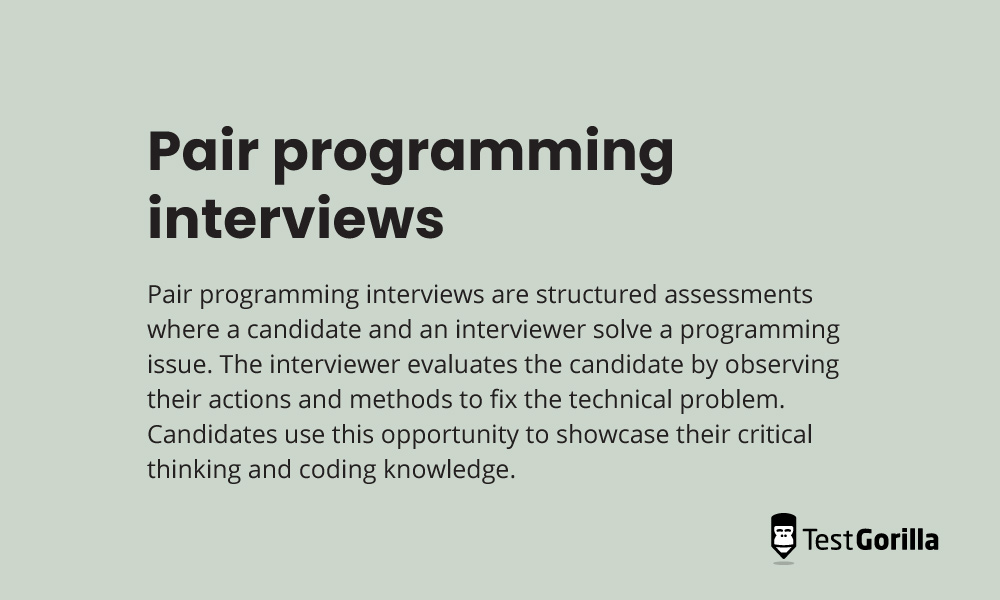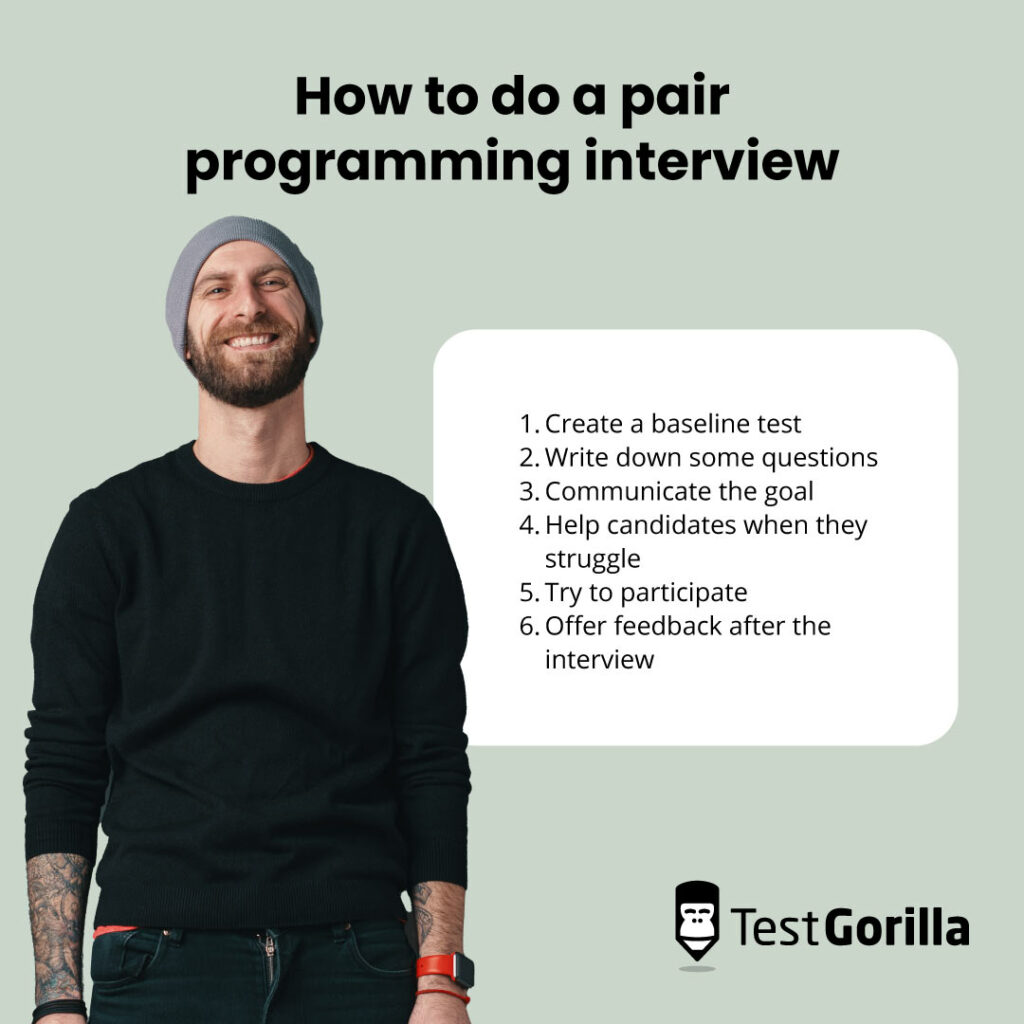The pair programming interview guide for employers
A pair programming interview is great for technical roles, but how should you structure one?
Do you focus on skills-based hiring techniques? What is the ideal preparation? These questions are important to consider when holding this type of interview.
Professional developers should be aware of common interview mistakes and the tools that can support the interview process. And your candidates need to feel engaged if they wish to pass the test, so what are the best ways to plan and navigate this problem-solving interview?
Read this guide to find out more about planning a pair programming interview and using high-quality assessment tools to improve your candidates’ experiences.
What is a pair programming interview?
Pair programming interviews are structured assessments where a candidate and an interviewer solve a programming issue. The interviewer evaluates the candidate by observing their actions and methods to fix the technical problem. Candidates use this opportunity to showcase their critical thinking and coding knowledge.
How to do a pair programming interview?
Once you’ve established that pair programming is the right interview style, you then need to think about how to conduct one. Here are some of the key steps to follow.
1. Create a baseline test
A baseline test is the most important thing for these interviews. The test represents a guideline that gives every candidate a fair and equal challenge. Make sure you use the same programming problem to form an unbiased opinion on every applicant.
You should use a realistic problem that employees in the business may have seen before. Consider the duration of this interview and how long it might take to solve the problem.
2. Write down some questions
Assemble a small list of questions that you can put to all candidates. For example, you might ask about their thought process or reasoning behind certain actions. It also helps to appear interested and engaged during the collaborative interview, especially if there are long moments of silence.
Remember that your questions should be simple and short to prevent candidates from going on long tangents or wasting time during the test.
3. Communicate the goal
Before starting the interview, communicate an end goal with your candidate. Tell them your expectations and how you plan to evaluate their performance. It’s also important to mention things they should avoid during the test to ensure they use the time efficiently.
4. Help candidates when they struggle
Don’t be afraid to help candidates in times of need. Some people are bound to feel nervous during a comprehensive programming test. You can ask questions to jog their memory or discuss the problem openly with candidates to help them feel more comfortable.
Candidates should do most of the thinking themselves, but it’s worth acknowledging their struggles to encourage them to be more confident.
5. Try to participate
Not participating in an interview means it’s a regular coding test. This isn’t good for candidates who are expecting something more collaborative. Find ways to engage with them by giving subtle hints or asking them about their current thoughts and feelings.
58% of job seekers decline roles after a poor experience. To avoid this happening to your recruitment process, listen actively and ask basic questions during the interview.
6. Offer feedback after the interview
Candidates are usually eager to receive some feedback. Once the interview has finished, tell them about their strengths and how well they performed. Try to be gentle with those who struggled or believe they failed the initial programming test.
Having an employee who can also take constructive feedback is important. Communicate ways your candidates can improve and discuss the mistakes they made. If a candidate seems eager to develop their skills, it may suggest they’re passionate about your business.
The best insights on HR and recruitment, delivered to your inbox.
Biweekly updates. No spam. Unsubscribe any time.
4 pair programming interview mistakes to avoid
Below are some common mistakes to avoid when conducting this type of interview.
Lack of communication
Not communicating with the candidate during their programming test could lead to more uncertainty and panic.
Deloitte has found that 80% of candidates tell others about a poor application experience, which can leave a bad impression on your business. It’s important to guide them through the interview by talking about their thought process or methods to solve the problem.
Being too distant
Even though your candidate is there to prove their skills independently, you should still act as the guide. This means you should give tips or hints when they get stuck. You can improve the collaborative experience by engaging with them, which also helps you test their communication skills.
Not asking questions
The worst thing you can do is sit back in silence. Candidates need interaction and should feel challenged when facing realistic programming issues. Put together a list of suitable questions beforehand that make the candidate think about their plan and strategy.
Here are some example questions:
“What do you think is the issue?”
“How would you approach this coding problem?”
“Can you show me your plan?”
Only following one solution
There is never one right answer when it comes to programming. Everyone has a unique way of approaching problems, especially in the coding world. Keep an open mind and you might be surprised by their creativity and ability to demonstrate problem-solving skills.
How long should a pair programming session be?
The average duration of a pair programming interview is 60 minutes. However, some can last up to 120 minutes, depending on the candidate’s knowledge.
These interviews should focus on progress rather than productivity or efficiency, and candidates shouldn’t feel pressured during the process. Make sure you communicate an ideal timeframe with the candidate beforehand. This helps them to prepare without constantly worrying about a countdown.
What to remember when holding your own pair programming interview
A pair programming interview is an excellent way to engage your candidates and test their skills in a technical setting.
Remember to create a comprehensive baseline that details questions, end goals, and common mistakes to avoid during the initial programming assessment. Also, keep in mind that candidates need something challenging and fun.
Make sure to check out TestGorilla’s guide to programming tests to help you hire the right people for your business. Sign up for a free account now and start designing your own pair programming interviews.
You've scrolled this far
Why not try TestGorilla for free, and see what happens when you put skills first.
















